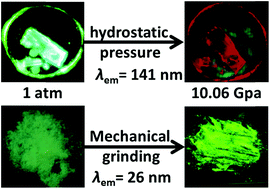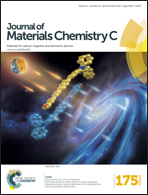Ratiometric pressure sensors based on cyano-substituted oligo(p-phenylene vinylene) derivatives in the hybridized local and charge-transfer excited state†
Abstract
Ratiometric sensors for visual monitoring of pressure environments are highly valuable in various fields, such as security inks and optoelectronic devices. However, ratiometric pressure sensors remain inadequate due to the lack of piezo-chromic luminescent materials with high-contrast color change and high emission efficiency. A donor–acceptor cyano-substituted oligo(p-phenylene vinylene) derivative mF-TPA exhibits a high luminescence efficiency (Φf = 82.6%), which is related to the hybridized local and charge-transfer (HLCT) states. Moreover, its crystalline particles can sense exact hydrostatic pressure as high as 10 GPa, accompanied by visible color changes (λPL = 146 nm, from light-green to deep-red). Interestingly, the photo-luminescence peak wavelengths have a linear relationship with the external pressure, enabling its use as a ratiometric pressure sensor. In situ Raman spectroscopy confirms that the intermolecular interaction is obviously enhanced due to the closer packing at high pressure, inducing a red-shift of the emission peak and a decrease of the fluorescence intensity.



 Please wait while we load your content...
Please wait while we load your content...